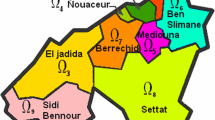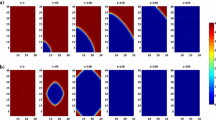Abstract
This paper presents a study of regional optimal control strategies of a spatiotemporal SIR epidemic model which is formulated from existing SIR epidemic models by including a diffusion term. Our main objective is to characterize the two optimal controls that minimize the number of infected individuals, the corresponding vaccination and treatment costs. For that matter, we prove the existence of a pair of control and provide a characterization of optimal controls in terms of state and adjoint functions. Finally, we present numerical simulations on data concerning the evolution of the zoonotic Ebola virus in Africa. Results show that control is effective if regional treatment and vaccine strategies are used simultaneously.









Similar content being viewed by others
References
Anderson RM, Jackson HC, May RM, Smith AM (1981) Population dynamics of fox rabies in europe. Nature 289(5800):765
Asano E, Gross LJ, Lenhart S, Real LA (2008) Optimal control of vaccine distribution in a rabies metapopulation model. Math Biosci Eng MBE 5(2):219–238
Bah EI, Lamah M-C, Fletcher T, Jacob ST, Brett-Major DM, Sall AA, Shindo N, Fischer WA, Lamontagne F, Saliou SM et al (2015) Clinical presentation of patients with ebola virus disease in Conakry, Guinea. New Engl J Med 372(1):40–47
Barbu V (2012) Mathematical methods in optimization of differential systems, vol 310. Springer, New York
Borchering RK, Liu H, Steinhaus MC, Gardner CL, Kuang Y (2012) A simple spatiotemporal rabies model for skunk and bat interaction in northeast Texas. J Theoretical Biol 314:16–22
Brezis H, Ciarlet PG, Lions JL (1999) Analyse fonctionnelle: théorie et applications, vol 91, Dunod, Paris
Buceta J, Johnson K (2017) Modeling the ebola zoonotic dynamics: interplay between enviroclimatic factors and bat ecology. PloS One 12(6):e0179559
Croicu A-M (2019) An optimal control model to reduce and eradicate anthrax disease in herbivorous animals. Bull Math Biol 81(1):235–255
Caillaud D, Levréro F, Cristescu R, Gatti S, Dewas M, Douadi M, Gautier-Hion A, Raymond M, Ménard N (2006) Gorilla susceptibility to ebola virus: the cost of sociality. Curr Biol 16(13):R489–R491
Camacho A, Kucharski A, Funk S, Breman J, Piot P, Edmunds W (2014) Potential for large outbreaks of ebola virus disease. Epidemics 9:70–78
Chowell G, Hengartner NW, Castillo-Chavez C, Fenimore PW, Hyman JM (2004) The basic reproductive number of ebola and the effects of public health measures: the cases of Congo and Uganda. J Theoret Biol 229(1):119–126
Garner MG, Lack M (1995) An evaluation of alternate control strategies for foot-and-mouth disease in Australia: a regional approach. Prev Vet Med 23(1–2):9–32
Geisbert TW, Pushko P, Anderson K, Smith J, Davis KJ, Jahrling PB (2002) Evaluation in nonhuman primates of vaccines against ebola virus. Emerg Infect Dis 8(5):503
Ivorra B, Ngom D, Ramos ÁM (2015) Be-codis: a mathematical model to predict the risk of human diseases spread between countries–validation and application to the 2014–2015 ebola virus disease epidemic. Bull Math Biol 77(9):1668–1704
Lewnard JA, Mbah MLN, Alfaro-Murillo JA, Altice FL, Bawo L, Nyenswah TG, Galvani AP (2014) Dynamics and control of ebola virus transmission in Montserrado, Liberia: a mathematical modelling analysis. Lancet Infect Dis 14(12):1189–1195
McAsey M, Mou L, Han W (2012) Convergence of the forward–backward sweep method in optimal control. Comput Optim Appl 53(1):207–226
Murray JD, Stanley E, Brown D (1986) On the spatial spread of rabies among foxes. Proc R Soc Lond B 229(1255):111–150
Neilan RM, Lenhart S (2011) Optimal vaccine distribution in a spatiotemporal epidemic model with an application to rabies and raccoons. J Math Anal Appl 378(2):603–619
Pazy A (2012) Semigroups of linear operators and applications to partial differential equations, vol 44. Springer, New York
Poulsen JR, Clark CJ (2004) Densities, distributions, and seasonal movements of gorillas and chimpanzees in swamp forest in Northern Congo. Int J Primatol 25(2):285–306
Qiu X, Audet J, Wong G, Fernando L, Bello A, Pillet S, Alimonti JB, Kobinger GP (2013) Sustained protection against ebola virus infection following treatment of infected nonhuman primates with zmab. Sci Rep 3:3365
Report of a WHO/International Study Team (1978) Ebola haemorrhagic fever in sudan, 1976. Bull World Health Organ 56(2):247
Rizkalla C, Blanco-Silva F, Gruver S (2007) Modeling the impact of ebola and bushmeat hunting on western lowland gorillas. EcoHealth 4(2):151–155
Smoller J (2012) Shock waves and reaction–diffusion equations, vol 258. Springer, New York
Sullivan NJ, Sanchez A, Rollin PE, Yang Z-Y, Nabel GJ (2000) Development of a preventive vaccine for ebola virus infection in primates. Nature 408(6812):605
Swanepoel R, Leman PA, Burt FJ, Zachariades NA, Braack L, Ksiazek TG, Rollin PE, Zaki SR, Peters CJ (1996) Experimental inoculation of plants and animals with ebola virus. Emerg Infect Dis 2(4):321
Vrabie II (2003) C0-semigroups and applications, volume 191 of north-holland mathematics studies
Walsh PD, Biek R, Real LA (2005) Wave-like spread of ebola zaire. PLoS Biol 3(11):e371
Walsh PD, Kurup D, Hasselschwert DL, Wirblich C, Goetzmann JE, Schnell MJ (2017) The final (oral ebola) vaccine trial on captive chimpanzees? Sci Rep 7:43339
Wang X, Shi Y, Feng Z, Cui J (2017) Evaluations of interventions using mathematical models with exponential and non-exponential distributions for disease stages: the case of ebola. Bull Math Biol 79(9):2149–2173
World Health Organization (2014) WHO: Ebola response roadmap situation report 15 october 2014
Zerrik E, Boutoulout A, Jai AE (2000) Actuators and regional boundary controllability of parabolic systems. Int J Syst Sci 31(1):73–82
Acknowledgements
The authors would like to thank all the members of the Editorial Board who were responsible of this paper, and the anonymous referees for their valuable comments and suggestions to improve the content of this paper.
Author information
Authors and Affiliations
Corresponding author
Additional information
Publisher's Note
Springer Nature remains neutral with regard to jurisdictional claims in published maps and institutional affiliations.
Appendix
Appendix
First recall a general existence result which we use in the sequel (Proposition 1.2, p. 175, (Barbu 2012); see also (Pazy 2012; Vrabie 2003). Consider the initial value problem
where A is a linear operator defined on a Banach space X, with the domain D(A) and \(f:[0,T]\times X\rightarrow X\) is a given function. If X is a Hilbert space endowed with the scalar product \((\cdot ,\cdot )\), then the linear operator A is called dissipative if \((Az,z)\le 0,\,\left( \forall z\in D(A)\right) \).
Theorem 5
X be a real Banach space, \(A:D(A)\subseteq X\rightarrow X\) be the infinitesimal generator of a \(C_{0}-\)semigroup of linear contractions \({S(t),\,t\ge 0}\) on X, and \(f:[0,T]\times X\rightarrow X\) be a function measurable in t and Lipschitz continuous in \(x\in X\), uniformly with respect to \(t\in [0,T]\).
- (i)
If \(z_{0}\in X\) , then problem (38) admits a unique mild solution, i.e., a function \(z\in C([0,T];X)\) which verifies the equality \(z(t)=S(t)z_{0}+\int _{0}^{t}S(t-s)f(s,z(s))\mathrm{d}s,(\forall t\in [0,T]\) .
- (ii)
If X is a Hilbert space, A is self-adjoint and dissipative on X and \(z_{0}\in D(A)\), then the mild solution is in fact a strong solution and \(z\in W^{1,2}(\left[ 0,T\right] ;X)\cap L^{2}(0,T;D(A))\)
Rights and permissions
About this article
Cite this article
El Alami Laaroussi, A., Rachik, M. On the Regional Control of a Reaction–Diffusion System SIR. Bull Math Biol 82, 5 (2020). https://doi.org/10.1007/s11538-019-00673-2
Received:
Accepted:
Published:
DOI: https://doi.org/10.1007/s11538-019-00673-2




